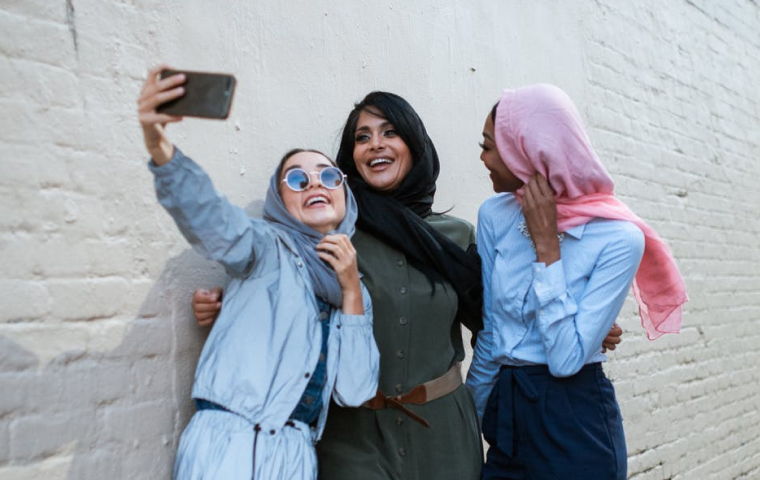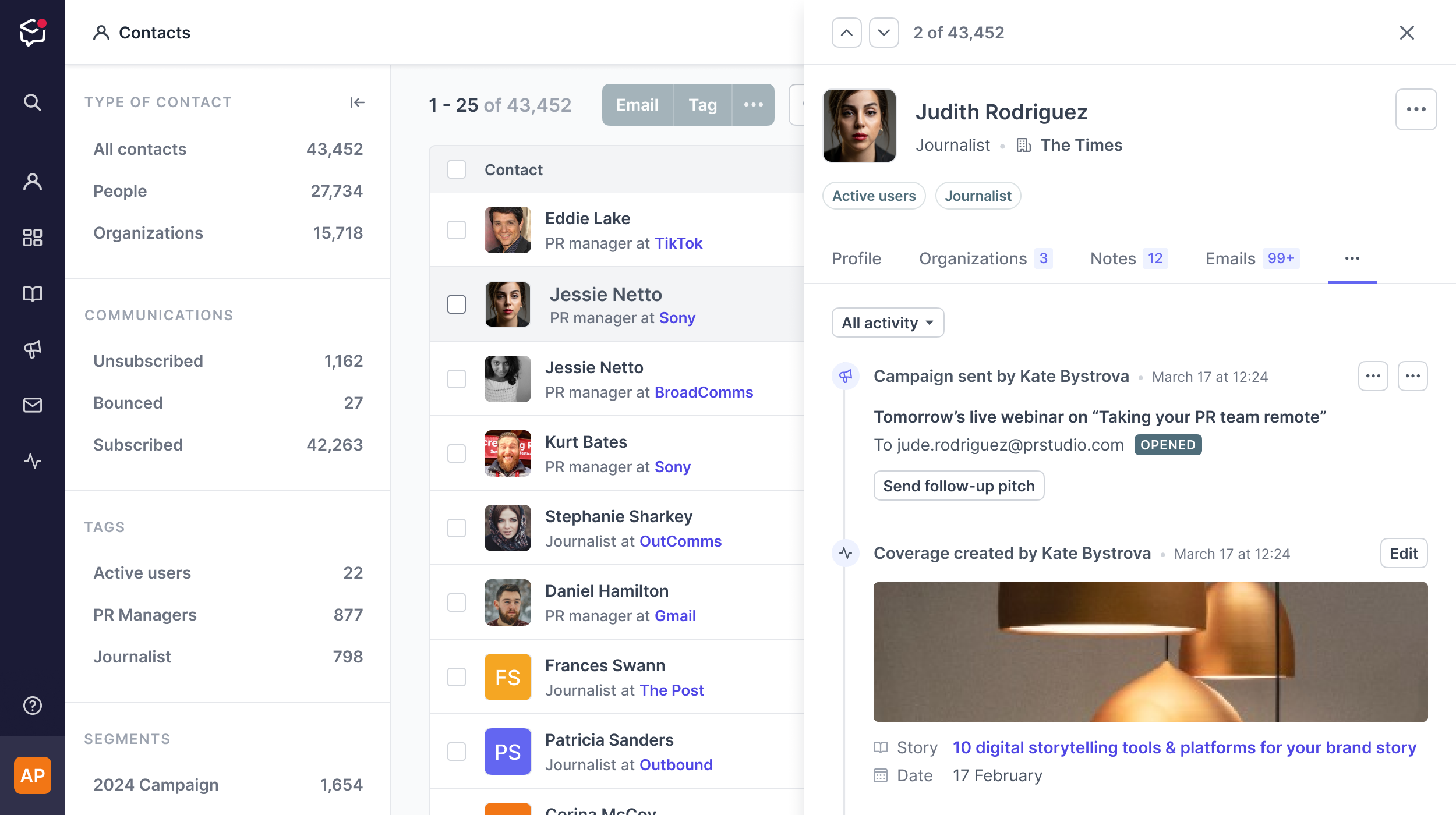How to do PR for your beauty brand in 2025 (with examples)
The top ten strategies for cosmetics, makeup, and skincare PR, according to industry experts
Whether you're working for a small indie cosmetics company or one of the industry-leading brands, beauty PR has its unique set of challenges. We'll break down the best ways to get PR for your skincare, cosmetics, makeup, and haircare brands, or dye (sic) trying.
Prezly – software for modern PR teams
Write & publish brand stories in an online newsroom
Send email campaigns, pitches & newsletters
Manage all your contacts in a single CRM, with easy import & export
Measure performance with analytics & built-in media monitoring

Apologies in advance for the amount of RuPaul's Drag Race gifs, but we're talking beauty, and we came to slay. 💅
Every PR niche has its difficulties. Food PR has the challenge of making the meals seem appealing and delicious (despite the lack of Smell-o-vision technology we were promised). Pharmaceutical PR has the challenge of making its products seem safe. Tesla PR has the challenge of Elon Musk.
But what about the beauty industry? What challenges do beauty PR professionals face, and what hurdles must be overcome to successfully market a beauty brand to the public?
1. Skincare and makeup are highly individualized
What works for one person's skin will absolutely not work for another's. This can make marketing to broad audiences quite complicated.
2. Cosmetics consumers are picky about quality (and skeptical about sourcing)
Many celebrities, reality TV stars, and social media personalities are jumping on the makeup line bandwagon. Some celebrity makeup brands have become incredibly successful (like Fenty by Rihanna, Haus Labs by Lady Gaga, or Real Beauty by Selena Gomez). And others, unfortunately, are just cash grabs. Celebrities (and the celebrity-adjacent) are leveraging their 15 minutes of fame to market cheap quality makeup at ridiculous markups.
3. Consumers have been burned by false promises
We all want the elixir of youth, and natural aging is obviously a sentence worse than death. The beauty industry has been terrorizing women (and to a lesser degree, men) into buying their products for hundreds of years to avoid a monstrous fate (wrinkles), but many "solutions" are just snake oil (and at least one is literal snake oil).
Overhyped, underdelivering products have made the average internet-using consumer wary of trusting any bold claims made by beauty PR.
4. The market is saturated
There are a lot of beauty brands out there. Even thinking about differentiating your brand in a sea of both conglomerate and indie brands can be daunting.
5. Beauty consumers tend to be brand-loyal
Cosmetics and skincare consumers often find a brand they like and stick with it for the rest of their natural, wrinkly lives. This, combined with the steep price points of many makeup and skincare products, can be a big, beefy hurdle for beauty PR.
6. The industry has been "Sephorized"
More than ever, customers are unlikely to buy products that they've never tried. Samples are an industry must, but are a huge cost burden to brands (not to mention a scourge on the environment).
So, now that we all know the hardships of beauty brand PR, how can we get that sweet, sweet coverage and make sure the people are sufficiently moisturized and bronzed?
Here are ten of our top tips for beauty PR (as informed by some knowledgeable experts) 💅
Journalists have an endless barrage of people in their inboxes who want to promote their products and get free media coverage. You can stand out from the crowd by engaging with the journalists as if they were actual human-people, collaborating with them, sending unique and meaningful pitches – and not just blasting your press release in their unsuspecting faces.
Try Prezly for free todayA great way to build relationships with journalists and establish yourself as a high-quality source of intel is to give journalists what they want in the way they want it. This often means having an organized online press kit with media galleries, downloadable assets, and all of the technical specs they could ever need to feature your brand. It does not mean "send 45 separate image attachments and destroy their inbox permanently".
Here's a phrase no #freelancewriter ever wants to hear: "I'm going to send you a bunch of emails because the files are so large." Good news! There are technology solutions to avoid this. (Please use them!)
An example 👇
Makeup giant Estée Lauder uses Prezly to dazzle the media with their gorgeous, aesthetic newsrooms that include high-quality images and downloadable PDFs of their product launches and press releases.

As previously mentioned, cosmetics and skin care products are not going to work the same on all skin types. Samples are a must, especially for indie brands that are up against hordes of well-established competitors with loyal buyers.
Samples can go directly to consumers, influencers, dermatologists and aestheticians, or can be included as part of event gift bags – anything to get your product to potential customers and industry movers and shakers.
It may be tempting to think of samples as a profit loss, but this could not be farther from the truth when it comes to beauty PR, as samples themselves have become a billion-dollar industry.
It is important to remember that PR is literally the relations you are building with the public. To create positive PR for a beauty brand in this environment you need to solidly know your exact person profile and get the products into their hands. I like to utilize focus groups, influencer marketing, swag contributions for events, and very intentional pop-up collaborations. I have worked with very small marketing/PR budgets that I have invested directly into product gifting opportunities, the ROI is better than anything else.
And you can even use those free samples to reflect your brand values of conservation and eco-greenness by not wrapping them in plastic. Instead, get creative with the packaging and any accompanying marketing to give people the opportunity to fall in love with your products – after all, this is your best chance to impress them.
Really can't afford free samples? UK deodorant brand AKT gets around this by offering mini sample tubes in its shop; the first one is free if you use a welcome code. People love it! Not only does this give newcomers a chance to try out their product, but it allows their already pretty vocal fanbase to try out new scents or use these as travel necessities.
Create a free press release with PrezlyThe beauty industry has a transparency problem. Many brands are choosing the "cheap and easy" route when it comes to sourcing and ingredients. In an already saturated market, this is one blemish beauty brands cannot afford to have.
Fortunately, that gives any beauty PR a place to start their messaging.
Pin down what your brand is doing differently and shout about it, whether it's that your ingredients are ethically sourced or that you don't test your anti-hair-loss cream at the local cat shelter. Basically, tell people all the ways that your brand goes against the grain of low-quality, generic cosmetics.
Here's a fantastic example of this sort of messaging in action.
Nylah's Naturals, a UK haircare brand, leads with how its product fights hair loss using a clinically-tested formula rather than simple relying on a thesaurus.

Influencers are important, everyone knows that.
But collaborating with an influencer to promote your products that have tons of followers is pretty pointless if the audience isn't tailored to your brand.
Instead of choosing influencers with the most followers, it's often better to partner with smaller creators whose content matches your niche and whose audiences are more likely to be interested (and ultimately purchase) your products.
At Lumineux Health, we have found success with the use of brand ambassadors to promote our products across various social media platforms. Partnering with brand ambassadors who already have a trusting relationship with their followers provides us with the demographics we are looking for. For example, we are able to partner with ambassadors who share our goals of promoting all natural products for whitening teeth as opposed to using chemicals and bleaches. Their followers are also looking for natural ingredients. By utilizing these ambassadors, they are able to demonstrate how to correctly use our teeth whitening products, share their own results, and provide information on how their followers can benefit from the products. Regardless of the campaign or ensure, ensure that you remain true to your brand.
The same is true with media coverage. If you're doing PR for a lady haircare brand, do you need to be in Motor Trends magazine? Sure, you'll be seen by a lot of people, but the odds of those readers purchasing that rose-scented scalp oil are… low.

A fun fact about humanity: people love lists. They love them. There's something about a product list that makes people go nuts. Overstimulation has collectively broken our brains, and readers are far more inclined to pay attention to a listicle or a product roundup than literally any other form of media in existence.
Is that an exaggeration?
- Maybe.
- But no.
See, you loved it.
Gift guides, top lists, and holiday roundups are fantastic ways to get your brand in front of new, consuming eyes.
Lists can be exceptionally useful if they happen to coincide with a product launch or promotion, but timing can be tricky and requires careful strategy, as explained by Jennifer Thomas from Beauty Results PR:
Holiday gifting is an easy play for earned media. How do your products fit into “Best gifts for her”; “Stocking Stuffers”; “Luxury Gifts”; “Self-Care Gifts”; “Gifts under $50”; “Gifts for Him”; “Gifts for Coffee Lovers (if your product has coffee as featured ingredient)” and more. Don’t forget Valentine’s Day, Mother’s Day, Father’s Day for pitching opportunities. Again, knowing the media’s deadline is key. One top tier national print beauty/consumer publication closes its holiday submissions on July 15th!
Getting your product featured in lists is another great strategy I employ for my clients. I had a client with a Vitamin C serum, so I researched “top Vitamin c serums” and found several curated lists. I pitched the writer of those lists and asked them to consider adding my client’s product next time they updated the list.
➡️ Learn more about creating a fantastic PR strategy
As previously mentioned, a saturated market is one of the biggest beauty PR hurdles. How is an indie brand, which will likely rely on online distribution and sales, going to compete with a brand that is available in every corner store (and probably at half the price)?
This is where the concept of differentiating yourself comes in.
Are you a black-owned business? Are your products vegan and cruelty-free? Do you have laudable CSR initiatives or donate to charity?
What sets you apart makes you special and creates not just customers, but loyal fans. And loyal fans are far more willing to go the extra mile to support their favorite companies than casual normie consumers. (I'd again like to point you towards the sheer volume of RuPaul gifs in this article by way of illustration.)
Lack of product innovation is a hurdle. As an indie brand, you have to be doing something special with ingredients, formulation, product development, sales, cult like customers and more to be noticed.
Authentic Beauty Concept did just this for World Vegan Month. Their press release showcased their low-waste, PETA-certified, vegan skincare line. Not only is it incredibly aesthetic, but the brand sets itself apart as one that is not only good for your skin, but also good for the planet.

Getting your brand into a major news publication is not the end of your PR story. Repurpose! Share, retweet, and let your fans know about the coverage.
Do not forget to remerchandise your success. Don’t let the success end with a media placement. How you use this placement to create excitement amongst your customers, your social media and collateral is often a piece of the PR puzzle people forget to utilize.
Great PR is exciting, so celebrate it! And let it work for you not just once, but over and over again.
Try Prezly media monitoring free for 14 days
- Automatically track your news media coverage
- Understand who is talking about your brand
- Create email reports with embedded coverage

The power of consumer reviews cannot be overstated. Consumers are far more likely to trust their friends, beloved influencers, family, and strangers on the internet than they are to trust an ad – especially when it comes to cosmetics.
One survey of beauty consumers showed that a whopping 74% of respondents said product reviews were crucial to building brand loyalty.
If you have happy customers, make sure they have a way to share the love. Those reviews, whether they're on social media or directly on your website, are incredibly powerful, and consumers want to see them.
The beauty industry has a long-standing authenticity problem. This may be in part because many beauty brands are trying to sell an idealized image of who consumers could be if only they bought the $100 bottle of skin-dampening juice. Whatever the root cause may be, consumers are becoming wary of this extremely sanitized version of The Beauty Gods On High Who Judge Everyone for Not Being Beautiful Enough.
We see this reflected in scandal after scandal of beauty brands lacking inclusivity, being egregiously tone-deaf, or sometimes just being outright offensive.
Many successful beauty brands are combating this lack of authenticity by showing the behind-the-scenes process of being a brand. This could be small business TikTokers showing their products being made or even large brands who document the step-by-step journey of their bath bombs being made.
No matter how you share the journey or story tell your business, audiences love authenticity.
One of the biggest hurdles I experience is standing out from the rest of the beauty brands in the market. Many of us share similar types of content and it can be difficult to break through the clutter resulting in an under-the-radar type of presence.
To combat this, I focus on tailoring high-quality PR campaigns that offer varied content from behind-the-scenes info to production details—all with a dose of reality injected into it. This helps me connect more deeply with potential customers and make sure they have access to all the information they need when considering buying my products.

27x more people visit Facebook than NYTimes.com. Isn't it time your PR went social?
Now that you're feeling inspired, why not continue the slay with more beauty press release examples?
Or, if you think Prezly may be helpful in your classification efforts, you can always sign up for our 14-day free trial.
Prezly – software for modern PR teams
Write & publish brand stories in an online newsroom
Send email campaigns, pitches & newsletters
Manage all your contacts in a single CRM, with easy import & export
Measure performance with analytics & built-in media monitoring

Ready to start growing your media reach?
With Prezly you can publish press releases online, and share them directly with journalists. 14-day free trial, no credit card required.





![Cision vs Meltwater vs Prezly: Which One Is Better? [2025]](https://cdn.uc.assets.prezly.com/10383ab0-88f1-4ac7-994e-a035003a47c7/-/resize/3000/prezly-vs-cision-meltwater.png)